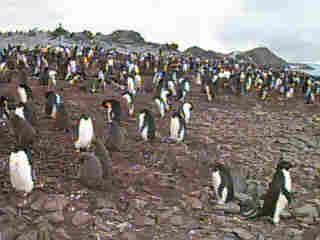27 January, 1998
Gould-en Greetings!
The visit last night to the nearby penguin rookery on Tergersen Island was
overpowering -- in more than one way! Imagine a heavy concentration of
land-based birds that feed on krill. If you've ever had shrimp at home
and smelled the shells the next day, you are a quarter of the way to
knowing what a penguin rookery smells like. However, that was well
overshadowed by the thrill of finally meeting penguins face to beak!
When we got on the island, there were about 10-15 Adelie penguins on the
shoreline. They were preening themselves, which is when a bird uses its
beak to go over each of the quill-like feathers thus ridding the feathers
of salt and any other unwanted coatings. The penguins are rather pretty
with white front feathers at that point. As one enters the main rookery,
chick feeding and accumulated detritus take their toll on the clean white
front of their "tuxedo." Nevertheless, they were still absolutely
fascinating. Picking up stones and moving from nest to nest; feeding
chicks; defending their small bit of turf; sheltering the chicks against
skua attacks; and eying us were all part of the routine on the island.
Adelie penguins are one of the most commonly depicted penguins. They have
a black head, back and wings with a plain white front. Another penguin, a
chinstrap, had joined the group but was looking a bit confused and was
definitely not part of the "in crowd." The chinstraps of this area breed
on Dream Island which is found on the seaward side and north of Palmer
Station. Occasionally, I am told, gentoo penguins also frequent the area.
They are located on Biscoe Island, which is further around Anvers Island
nearer the peninsula. Chipstrap penguins have just a cap of black on their
heads and a distinct black line under their ______ - you guess! Gentoos
always look to me as if they have a big white bow on their heads because of
the white patches on both sides of the head.
I talked with scientist Peter Duley today who is in Principal Investigator
Bill Fraser's group. He is studying about the reproductive success and the
health of penguins in the Antarctic Peninsula area. You will read more
about him and his studies later when I highlight each of the scientists and
their work as we continue our cruise.
Today I helped get things set up for the cruise. I labelled bottles, made
up solutions, and washed bottles. Exciting, huh? Actually it is quite
exciting to prepare for such an intensive study of the relatively untouched
water here. Just like most projects, there is a great deal of planning to
be done before the actual testing takes place. But the preparations help
in understanding what is to be done and how it is to be done.
Hope you enjoy the picture of the penguins. It was taken on January 26th
with a digital camera. All of the pictures on my web site have been taken
with this same camera that doesn't use film. It is called a digital camera
because it just takes pictures that can go directly into a computer. These
are current photos, so enjoy the sights of Antarctica with me!
If you have any penguin questions, please write!
Warm Regards,
Mrs D

Contact the TEA in the field at
.
If you cannot connect through your browser, copy the
TEA's e-mail address in the "To:" line of
your favorite e-mail package.
|
